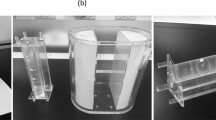Abstract
Purpose
Currently, traumatic bone diseases are diagnosed by assessing the micro 99mTc-hydroxymethylene diphosphonate (HDP) uptake in injured trabeculae with ongoing osteoneogenesis demonstrated by gamma correction pinhole scan (GCPS). However, the mathematic size quantification of micro-uptake is not yet available. We designed and performed this phantom-based study to set up an in-vitro model of the mathematical calculation of micro-uptake by the pixelized measurement.
Methods
The micro 99mTc-HDP deposits used in this study were spontaneously formed both in a large standard flood and small house-made dish phantoms. The processing was as follows: first, phantoms were flooded with distilled water and 99mTc-HDP was therein injected to induce micro 99mTc-HDP deposition; second, the deposits were scanned using parallel-hole and pinhole collimator to generally survey 99mTc-HDP deposition pattern; and third, the scans underwent gamma correction (GC) to discern individual deposits for size measurement.
Results
In original naïve scans, tracer distribution was simply nebulous in appearance and, hence, could not be measured. Impressively, however, GCPS could discern individual micro deposits so that they were calculated by pixelized measurement. Phantoms naturally formed micro 99mTc-HDP deposits that are analogous to 99mTc-HDP uptake on in-vivo bone scan. The smallest one we measured was 0.414 mm. Flooded phantoms and therein injected 99mTc-HDP form nebulous micro 99mTc-HDP deposits that are rendered discernible by GCPB and precisely calculable using pixelized measurement.
Conclusions
This method can be used for precise quantitative and qualitative diagnosis of bone and joint diseases at the trabecular level.





Similar content being viewed by others
References
Bahk YW, Jeon HS, Kim JM, Park JM, Chung YA, Kim EE, et al. Novel use of gamma correction for precise 99mTc-HDP pinhole bone scan diagnosis and classification of knee occult fractures. Skelet Radiol. 2010;39:807–13.
Bahk YW, Chung YA, Park JM. Use of gamma correction pinhole bone scans in trauma. Nucl Med Mol Imaging. 2012;46:10–9.
Bahk YW. Gamma correction pinhole bone scan diagnosis. In: Bahk YW, editor. Combined scintigraphic and radiographic diagnosis of bone and joint diseases. 4th edn. Heidelberg: Springer; 2013. p. 509–89.
Yoon DK, Jung JY, Suh TS. Application of proton boron fusion reaction to radiation therapy: a Monte Carlo simulation study. Appl Phys Lett. 2014;105:223507.
Yoon DK, Jung JY, Han SM, Suh TS. Statistical analysis for discrimination of prompt gamma ray peak induced by high energy neutron: Monte Carlo simulation study. J Radioanal Nucl Chem. 2015;303:859–66.
Elyutina AS, Kiger III WS, Portnov AA. NCTPlan application for neutron capture therapy dosimetric planning at MEPhI nuclear research reactor. Appl Radiat Isot. 2011;69:1888–91.
Papp J. Quality assurance in nuclear medicine. In: Papp J, editor. Quality management in the imaging sciences. Louis: Mosby; 2011. p. 273–95.
Saha GB. Fundamentals of nuclear pharmacy. 5th edn. Heidelberg: Springer; 2004.
Acknowledgments
We are grateful to Dr. Yoon Kwang Kim, the Chairman of Sung-Ae Medical Foundation for his generous support. Our thanks are due to Mr. Jae-Wan Kim and Mr. Taeyeong Shin for their devoted technological assistance. We also gladly acknowledge Mr. Woo Jin Chang for his knowledgeable reference work.
Author information
Authors and Affiliations
Corresponding author
Ethics declarations
The manuscript has not been published before or is not under consideration for publication anywhere else and has been approved by all co-authors.
Conflict of Interest
Joo-Young Jung, Gi Jeong Cheon, Yun-Sang Lee, Seunggyun Ha, Mi-Hye Chae, Yong-An Chung, Do Kyun Yoon, and Yong-Whee Bahk declare that they have no conflict of interest.
Human and Animal Rights and Informed Consent
This article does not contain any studies with human participants or animals performed by any of the authors.
Rights and permissions
About this article
Cite this article
Jung, JY., Cheon, G.J., Lee, YS. et al. Pixelized Measurement of 99mTc-HDP Micro Particles Formed in Gamma Correction Phantom Pinhole Scan: a Reference Study. Nucl Med Mol Imaging 50, 207–212 (2016). https://doi.org/10.1007/s13139-015-0391-8
Received:
Accepted:
Published:
Issue Date:
DOI: https://doi.org/10.1007/s13139-015-0391-8




